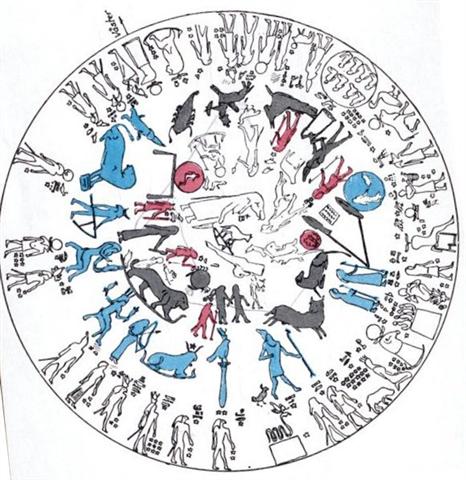1. Once again, possibly the G text covers the time measured in rectascension minutes from the rise of Sirius (Reitanga) to the rise of Toliman:
I consulted Wikipedia to find out if my rectascension numbers were correct:
Of course there must be small differences depending on how exact the measurments are, and another factor is the change in position depending on the date - the precession will gradually increase the rectascention value for a given star. The very small movements of a 'fixed' star against the fixed background, on the other hand, is of less importance. Furthermore, anciently there was a tendency to ignore small differences when describing reality, at least if there was no explanation ready at hand. One glyph in G could correspond to 1 minute of rectascension. Sirius should be immediately before the beginning of the 16 lines of glyphs. With 8 * 59 = 472 days as another possible measure for the G text I have earlier thought it was necessary to count Gb8-30 twice. However, another solution is to imagine the 'station' of Sirius to be on the threshold but not inside (not on the tablet). Counting from Sirus to Toliman there are 472 minutes, which is exactly equal to 4 months given that we count each hour of rectascension as 59 minutes (472 / 59 * 12 / 24 = 4). But with 59 minutes for each hour it seems more reasonable to count the distance between Sirius and Toliman as 472 / 59 * 10 / 16 = 5 months, especially as Sun basically should have only 10 months. However, the distance counted in zodiacal figures could be longer than 5:  Only by regarding the bluemarked lady archer as the same sign as the preceding 'cow' (with Sirius drawn as a star) can we reach 5 at the last of the bluemarked figures (alias The Mad Dog, another canine figure). If we count the blue lady as a separate sign, then the total number of months for Sun will be 6 / 5 * 10 = 12 (and 472 / 59 * 12 / 16 = 6 months will be the distance from Sirius to Toliman). Neither Sirius nor Toliman are mentioned in the list of Tahitian star pillars:
We should notice, though, that beginning with Ana-roto there are 5 pillars which lie within the rectascension interval defined by Sirius and Toliman. 2 + 5 = 7, which in the week will set out Sun and Moon as the initial pair corresponding to Ana-mua and Ana-muri. Ana-roto will then correspond to the day of Mars, which suits him well because spring is the season of central importance for the process of procreation. From One comes Two, and from Two comes Three. From Three everything else will then be generated. According to my imagined pattern Ana-tipu will be the day of Mercury. He lacks the stability needed to be a pillar and therefore reinforcement has to be fetched from the region of the North Pole. |
||||||||||||||||||||||||||||||||||||||||||||||||||||||||||||||||||||||||||||||||